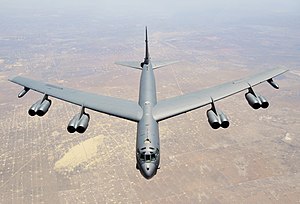
Back Boeing B-52 Stratofortress Afrikaans Boeing B-52 Stratofortress AN بي-52 ستراتوفورتريس Arabic بى-52 ARZ Boeing B-52 Stratofortress AST Boeing B-52 Stratofortress Azerbaijani Boeing B-52 Stratofortress Byelorussian Боинг B-52 Bulgarian Boeing B-52 Stratofortress Breton Boeing B-52 BS
| B-52 Stratofortress | |
|---|---|

| |
| A B-52H from Barksdale AFB flying over Texas | |
| Role | Strategic bomber |
| National origin | United States |
| Manufacturer | Boeing |
| First flight | 15 April 1952 |
| Introduction | February 1955 |
| Status | In service |
| Primary users | United States Air Force NASA (historical) |
| Produced | 1952–1962 |
| Number built | 744[1] |
The Boeing B-52 Stratofortress is an American long-range, subsonic, jet-powered strategic bomber. The B-52 was designed and built by Boeing, which has continued to provide support and upgrades. It has been operated by the United States Air Force (USAF) since the 1950s, and NASA for over 40 years. The bomber can carry up to 70,000 pounds (32,000 kg) of weapons [2] and has a typical combat range of around 8,800 miles (14,200 km) without aerial refueling.[3]
Beginning with the successful contract bid in June 1946, the B-52 design evolved from a straight wing aircraft powered by six turboprop engines to the final prototype YB-52 with eight turbojet engines and swept wings. The B-52 took its maiden flight in April 1952. The B-52 has been in service with the USAF since 1955, and NASA from 1959 to 2007.[4] Built to carry nuclear weapons for Cold War–era deterrence missions, the B-52 Stratofortress replaced the Convair B-36 Peacemaker.
Superior performance at high subsonic speeds and relatively low operating costs have kept them in service despite more advanced strategic bombers, such as the Mach 2+ Convair B-58 Hustler, the canceled Mach 3 North American XB-70 Valkyrie, the variable-geometry Rockwell B-1 Lancer, and the stealth Northrop Grumman B-2 Spirit. A veteran of several wars, the B-52 has dropped only conventional munitions in combat.
The B-52's official name Stratofortress is rarely used; informally, the aircraft has become commonly referred to as the BUFF (Big Ugly Fat Fucker/Fella).[5][6][7][Note 1] There are 72 aircraft in inventory as of 2022[update];[9] 58 operated by active forces (2nd Bomb Wing and 5th Bomb Wing), 18 by reserve forces (307th Bomb Wing), and about 12 in long-term storage at the Davis-Monthan AFB Boneyard.[2][3][10][11][12] The bombers flew under the Strategic Air Command (SAC) until it was disestablished in 1992 and its aircraft absorbed into the Air Combat Command (ACC); in 2010, all B-52 Stratofortresses were transferred from the ACC to the new Air Force Global Strike Command (AFGSC). The B-52 completed 60 years of continuous service with its original operator in 2015. After being upgraded between 2013 and 2015, the last airplanes are expected to serve into the 2050s.
- ^ Knaack 1988, p. 291.
- ^ a b "Fact Sheets: 5th Bomb Wing". 30 October 2019. Archived from the original on 31 May 2021.
- ^ a b "B-52 Stratofortress". USAF. Retrieved 2 March 2023.
- ^ "B-52 Heavy-lift Airborne Launch Aircraft". NASA. 14 September 2023. Retrieved 25 February 2024.
- ^ Sanders, Gordon F (20 January 2018). "The Incredible 50-year-old Plane on the Front Lines of the North Korea Standoff". POLITICO Magazine.
- ^ "BUF". Wordorigins.org. Archived from the original on 27 July 2010.
- ^ B 52 Instant Thunder (Television production). Wings. Discovery Channel. 17 April 2019.
- ^ Flinn 1997, p. 138.
- ^ Cite error: The named reference
WAF_2023was invoked but never defined (see the help page). - ^ "Facts Sheets: 2nd Bomb Wing". March 2021. Archived from the original on 2 November 2022.
- ^ "307th Bomb Wing-About Us". 25 September 2021. Archived from the original on 25 September 2021.
- ^ Trevithick, Joseph (19 February 2015). "I'll Be Damned, These Boneyard B-52s Can Still Fly". Medium.
Cite error: There are <ref group=Note> tags on this page, but the references will not show without a {{reflist|group=Note}} template (see the help page).
© MMXXIII Rich X Search. We shall prevail. All rights reserved. Rich X Search